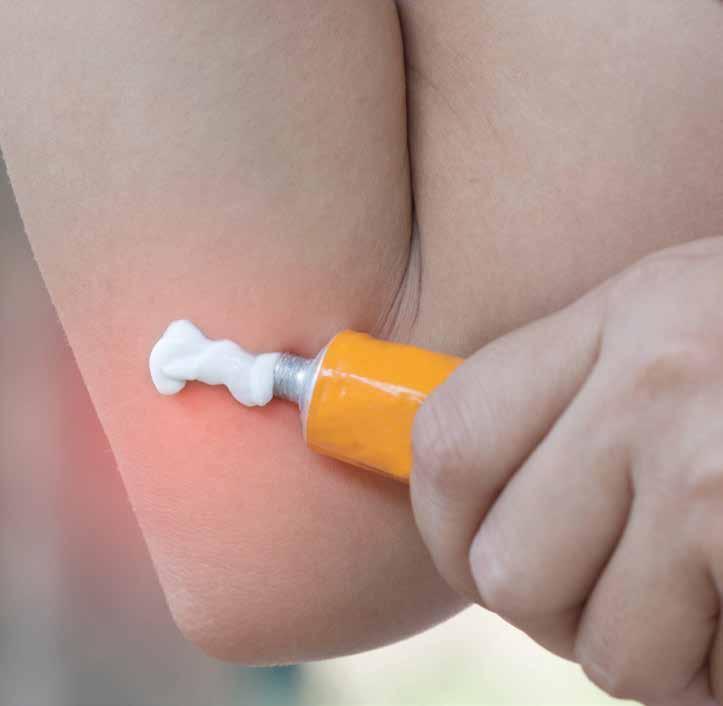
5 minute read
Dry Skin
Dry skin (xerosis) occurs when the epidermis does not hold on to sufficient moisture, so skin can feel tight, rough, flaky and itchy. A number of things can contribute to its development, for example; too frequent bathing, use of harsh drying soaps, the ageing process (the production of natural oils in the skin slows as we age) and sun damage or certain conditions such as eczema or psoriasis. The average skincare category accounts for 5 per cent of total OTC shelf space. It is important that this space works hard for you and the range stocked provides maximum return in terms of profitability as well as offering customers the right range of specialist skincare treatments to meet their needs.
SYMPTOMS
Dry skin will manifest initially in skin colour and texture, becoming red and rough. It may also result in flaking, gray or ashy skin, and itching (pruritus). In worst case scenarios, sufferers of dry skin might present with very severe peeling, or deep cracks that may bleed. At this point, they should be advised to consult a dermatologist in order to avoid scarring or infection.
Causes
Whilst genetics have a role to play in dry skin, there are a number of environmental factors that contribute to the condition.
Temperature: As temperatures and humidity levels drop in the winter, skin is likely to dry out. Indoor conditions will have a similar impact - a very warm home will lead to decreased moisture in the air which also dries the skin.
Cleansing habits: Skin can dry out if it is exposed to any harsh products, skincare or detergents, designed to wash away natural oils. Additionally, taking very long, hot baths or showers will reduce moisture in the skin.
Skin conditions: There are many skin conditions which can lead to dry skin, the most common being eczema or psoriasis. Atopic dermatitis can be activated by incessantly dry skin left untreated.
TREATMENTS
Moisturisers
People suffering from dry skin should avoid harsh, alcohol-based products, as these can irritate skin and dry it out. People who have oily skin should avoid oil-based products and choose water-based ones instead. A good moisturiser is not necessarily an expensive one. Deciding what is best for skin depends on ingredients. There are various ingredients that provide different functions including:
Ceramides. Ceramides help the skin hold water and soothe dry skin. Synthetic ceramides may mimic the natural substances in the outermost layer of skin that help keep moisture in.
Dimethicone and glycerin. These draw water to the skin and keep it there. Hyaluronic acid. Like ceramides, hyaluronic acid helps skin hold water.
Lanolin, mineral oil, and petroleum jelly (petrolatum). These help skin hold on to water absorbed during bathing.
Advise and Assist
Here are 5 tips pharmacists and pharmacy staff can advise sufferers on as efficient selfcare management:
1: More moisturiser
Emollients are moisturisers that are used in two ways: applied directly to the skin as a leave-on moisturiser, and as a soap substitute instead of soap and shower gel. Dry skin itches. Moisturising rehydrates the epidermis, seals in moisture, and soothes dry, itchy skin. In winter, sufferers may need to moisturise more frequently and/or use a ‘heavier’ moisturiser such as an ointment rather than a cream or lotion; ointments tend to work better when the skin is very dry.
Applying moisturiser:
Apply a 50p piece-sized amount of moisturiser to the face and neck, from the chest upwards.
Application should be even, across the whole area, especially when using a day cream with in-built sun protection.
Moisturisers can be applied immediately after a serum or, if not using a serum, directly after cleansing, to help trap essential moisture inside the skin.
Moisturise while skin is still moist. Patt skin with a towel after a shower or washing the face or hands, leaving it damp. Apply a moisturiser within three to five minutes of washing to lock moisture in.
Advise customers not to apply face cream to the eye area, as this requires a specific eye cream. Many moisturisers may be too rich in oils for the eye area and cause puffiness, or contain high levels of hydroxy acids, which may cause irritation.
2: Keep it simple - avoid harsh products
The best products to prevent flare ups of dry skin will be bland, unfragranced and preservative-free. Ordinary soaps and bubble baths can dry out the skin by stripping away its natural oils. Skin pH is a measure of acidity and alkalinity, ranging on a scale form 0 (most acidic) to 14 (the most alkaline). Healthy skin is naturally acidic, with a pH of around 5.5. This acidity plays an important role in skin barrier function and skin health. Soaps and detergents raise skin pH which disrupts this delicate balance. Use emollient wash products (soap substitutes) when hand-washing, bathing or showering, which leave the skin coated with a protective film afterwards. After bathing or showering, gently pat the skin dry. This is a great time to apply emollient all over as it helps to seal in moisture while skin is still damp.
3: One quick daily dip!
Staying in the bath or shower too long can be dehydrating- anyone suffering from dry skin should limit themselves to a single 5- or 10-minute warm shower or bath a day. Additionally, water temperature should be lukewarm rather than hot, as hot water strips oils from the skin faster than warm water.
4: Wear sunscreen
Sun damage is cumulative, so a lifetime of sun exposure and sun damage can result in thinner skin that doesn’t retain moisture well. This can also reduce the appearance of premature ageing.
5: Consider using a humidifier
Humidifiers moisten the air to increase the level of humidity. To combat the drying effects of central heating and lower humidity during winter, some may want to consider using a humidifier indoors when the heating is on.










